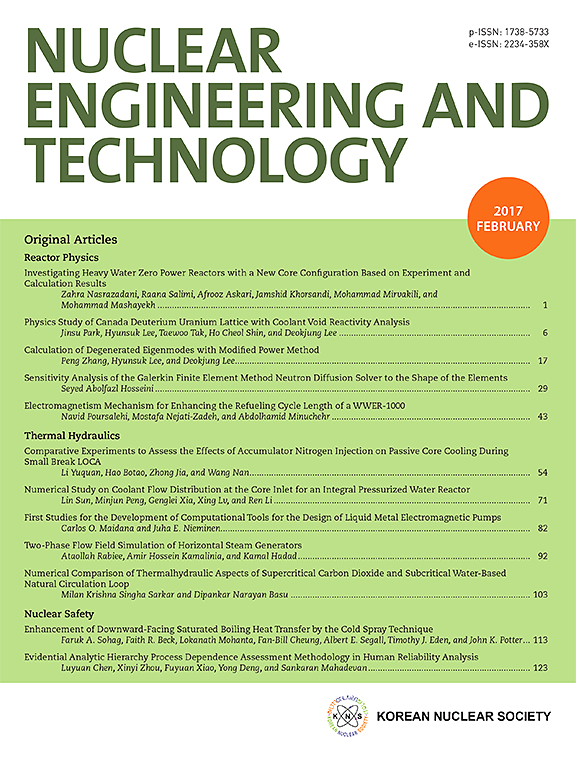Application of the smoothed particle hydrodynamics method to the neutron diffusion equation
IF 2.6
3区 工程技术
Q1 NUCLEAR SCIENCE & TECHNOLOGY
引用次数: 0
Abstract
A novel meshless method, known as Smoothed Particle Hydrodynamics (SPH), is applied to solve the neutron diffusion equation for the first time. The discrete forms for each term of the neutron diffusion equation and the boundary conditions are presented, along with a discussion on the differences among various discretization strategies. A comprehensive workflow for solving the neutron diffusion equation using SPH is provided, and the properties of several commonly used kernel functions are examined. An in-house code was developed, and the research indicates that not discretizing the constant terms in the diffusion equation but instead using the values from the previous iteration results in higher accuracy and is less sensitive to variations in parameters such as the smoothing length. A similar finding is observed for boundary conditions; when the boundary condition is of the first kind, directly assigning values yields greater accuracy than using kernel function interpolation. Among the compared kernel functions, the super-Gaussian kernel exhibits the best performance, with errors not exceeding 2.38 % under the given conditions, significantly outperforming the Gaussian and quintic spline kernel functions.
光滑粒子流体力学方法在中子扩散方程中的应用
首次将光滑粒子流体力学(SPH)这一新的无网格方法应用于中子扩散方程的求解。给出了中子扩散方程每一项的离散形式和边界条件,并讨论了各种离散化策略的区别。给出了用SPH求解中子扩散方程的完整工作流程,并对几种常用核函数的性质进行了检验。开发了内部代码,研究表明,不离散扩散方程中的常数项,而是使用先前迭代的值,可以获得更高的精度,并且对平滑长度等参数的变化不敏感。在边界条件下也有类似的发现;当边界条件是第一类时,直接赋值比使用核函数插值产生更高的精度。在所比较的核函数中,超高斯核函数表现出最好的性能,在给定条件下误差不超过2.38%,显著优于高斯核函数和五次样条核函数。
本文章由计算机程序翻译,如有差异,请以英文原文为准。
求助全文
约1分钟内获得全文
求助全文
来源期刊

Nuclear Engineering and Technology
工程技术-核科学技术
CiteScore
4.80
自引率
7.40%
发文量
431
审稿时长
3.5 months
期刊介绍:
Nuclear Engineering and Technology (NET), an international journal of the Korean Nuclear Society (KNS), publishes peer-reviewed papers on original research, ideas and developments in all areas of the field of nuclear science and technology. NET bimonthly publishes original articles, reviews, and technical notes. The journal is listed in the Science Citation Index Expanded (SCIE) of Thomson Reuters.
NET covers all fields for peaceful utilization of nuclear energy and radiation as follows:
1) Reactor Physics
2) Thermal Hydraulics
3) Nuclear Safety
4) Nuclear I&C
5) Nuclear Physics, Fusion, and Laser Technology
6) Nuclear Fuel Cycle and Radioactive Waste Management
7) Nuclear Fuel and Reactor Materials
8) Radiation Application
9) Radiation Protection
10) Nuclear Structural Analysis and Plant Management & Maintenance
11) Nuclear Policy, Economics, and Human Resource Development
 求助内容:
求助内容: 应助结果提醒方式:
应助结果提醒方式:


